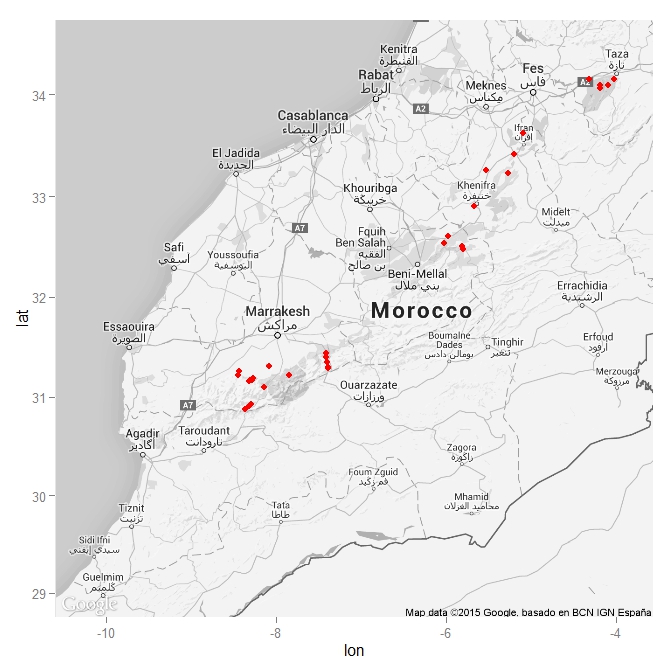I will focus upon the taxonomy of Narcissus sections Apodanthi and Jonquillae during my PhD project. I started in January and since members of the genus are almost entirely spring flowering, so I had to organise fieldwork rather quickly in order to collect specimens from wild populations during the first season. The two sections I am studying are almost entirely found within the Iberian Peninsula and Morocco. I firstly chose to target those species found within Morocco with only 3 species from the montane section Apodanthi and 1 section Jonquillae species being found there, however this Jonquillae species is autumnal flowering.
Herbarium specimens from Reading and Kew as well as digitised type specimens from Montpellier and Paris herbaria were firstly examined to find localities and information on flowering times etc. This information was accompanied by localities within several literature sources, and those uploaded to GBIF. Potential localities where identified within the High and Middle Atlas Mountains, which would target; N. rupicola subsp. watieri and N. rupicola subsp. marvieri. The third species N. albimarginatus will be more easily sampled whilst making collections within the Iberian Peninsula.
The expedition took place at the end of March 2015, chosen because of previous collecting dates and recorded flowering times for local Narcissus; I was accompanied by Dr. Stephen Jury, who has vast experience of the Moroccan flora and co-authored the Checklist of vascular plants of N. Morocco. During the expedition, visits to Caddi Ayyad University Herbarium and The Institut Scientifique de Rabat Herbarium (RAB) were made, and relevant Narcissus specimens photographed. After these visits I travelled to the northern most point of the expedition to search for a N. rupicola subsp. marvieri population within the Tazzeka National Park, travelling south taking a mountainous route back towards Marrakech thereafter searching several poorly recorded but potential locations near El-Ksiba on route.
Upon reaching Marrakech several days were spent searching the nearby; Tizi-n-Test, Tizi-n-Tichka passes and Oukaimeden. Prof. Ahmed Ouhammou from Cadi Ayyad University, who studies the flora of the High Atlas accompanied us during the visit to Oukaimeden.
Oukaimeden and Jebel Tazzeka were still under snow, this is at over 1800m, thus the populations could not be located, the locations described surrounding El Ksiba and Tizi-n-Tichka was also searched. A small population of Narcissus rupicola subsp. watieri was found near the Tizi-n-Test pass; with material collected and pressed to create herbarium specimens and leaf samples collected and stored in silica gel for molecular analysis.
Populations of other Narcissus species were found during the expedition notably from sections Bulbocodii and Tazzatae, with material also collected for analysis. Living material has also been collected during the expedition and these living plants were potted on return and have now joined the existing living collection at the University of Reading. Such material, with a definite and known origin is absolutely vital to my project.
During the expedition I gained very valuable experience in completing fieldwork within another country and have met several valuable contacts which will be extremely useful for organising future fieldwork. I am about to begin laboratory training with the aim to process what samples were collected during the fieldwork as soon as possible, after I have refined the protocol. I also wish to plan and undertake a short expedition to sample populations of the autumnal flowering N. viridiflorus later this year.







